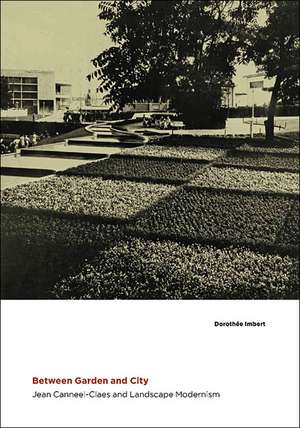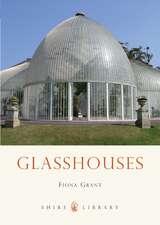Between Garden and City: Jean Canneel-Claes and Landscape Modernism
Autor Dorothée Imberten Limba Engleză Hardback – 28 oct 2009
In Between Garden and City, Dorothée Imbert examines the career of Belgian landscape architect Jean Canneel-Claes (1909-1989), firmly establishing his place in the modernist movement. Canneel's theoretical positions and innovative designs sought to align the emergent landscape profession with architecture and urbanism while demonstrating its potential to address the needs of modern society.
Canneel studied at La Cambre (Belgium's equivalent to the Bauhaus) under landscape urbanist Louis van der Swaelmen and graduated as the school's first landscape architect in 1931. Dedicated to connecting architecture and garden design, he commissioned a house from Le Corbusier and collaborated with prominent Belgian modernist architects Louis Herman De Koninck, Huib Hoste, and Victor Bourgeois. Seeing the garden as part of a larger design environment, Canneel expanded the scale of his interventions to urban greening and the planning of cities.
In 1938, Canneel joined forces with Christopher Tunnard to found the International Association of Modernist Garden Architects and further the cause of landscape modernism across Europe. Two years later, Canneel applied his theory of the functionalist garden to postwar reconstruction with designs for cemeteries, sports grounds, and town squares.
Imbert examines the social context and the aesthetic and theoretical influences that shaped Canneel's work. She positions him as a major figure at the confluence of art, architecture, and urbanism in the early twentieth century and opens new avenues for understanding the relationship of modernism to gardens, nature, and the city.
Canneel studied at La Cambre (Belgium's equivalent to the Bauhaus) under landscape urbanist Louis van der Swaelmen and graduated as the school's first landscape architect in 1931. Dedicated to connecting architecture and garden design, he commissioned a house from Le Corbusier and collaborated with prominent Belgian modernist architects Louis Herman De Koninck, Huib Hoste, and Victor Bourgeois. Seeing the garden as part of a larger design environment, Canneel expanded the scale of his interventions to urban greening and the planning of cities.
In 1938, Canneel joined forces with Christopher Tunnard to found the International Association of Modernist Garden Architects and further the cause of landscape modernism across Europe. Two years later, Canneel applied his theory of the functionalist garden to postwar reconstruction with designs for cemeteries, sports grounds, and town squares.
Imbert examines the social context and the aesthetic and theoretical influences that shaped Canneel's work. She positions him as a major figure at the confluence of art, architecture, and urbanism in the early twentieth century and opens new avenues for understanding the relationship of modernism to gardens, nature, and the city.
Preț: 510.55 lei
Nou
Puncte Express: 766
Preț estimativ în valută:
97.69€ • 102.27$ • 80.83£
97.69€ • 102.27$ • 80.83£
Carte disponibilă
Livrare economică 17-31 martie
Preluare comenzi: 021 569.72.76
Specificații
ISBN-13: 9780822943709
ISBN-10: 0822943700
Pagini: 360
Ilustrații: 161 Illustrations
Dimensiuni: 178 x 229 x 23 mm
Greutate: 0.95 kg
Ediția:First Edition, 1st Edition
Editura: University of Pittsburgh Press
Colecția University of Pittsburgh Press
ISBN-10: 0822943700
Pagini: 360
Ilustrații: 161 Illustrations
Dimensiuni: 178 x 229 x 23 mm
Greutate: 0.95 kg
Ediția:First Edition, 1st Edition
Editura: University of Pittsburgh Press
Colecția University of Pittsburgh Press
Recenzii
“A important study . . . a result of a considerable and comprehensive research process and a valuable source of detailed information. The study offers important criticism of functionalist landscape theory and practice, and Imbert has done much to re-establish the status of Jean Canneel-Claes as a talented architect-paysagiste-urbaniste of the 20th century.”
—Journal of Landscape Architecture
—Journal of Landscape Architecture
“An original work that sheds light on the overlooked modernist Belgian scene, focusing on the work of the remarkable garden architect Jean Canneel-Claes. Thanks to Dorothée Imbert's solid new interpretation and the exciting visual materials found in the archives, the genealogy of modernist landscape in Europe is significantly clarified.”
—Jean-Louis Cohen, Institute of Fine Arts, New York University
—Jean-Louis Cohen, Institute of Fine Arts, New York University
“This gem of a book is wonderfully illustrated with rare archival photographs and landscape plans.”
—Chicago Botanic Garden
—Chicago Botanic Garden
“With a dearth of writing focused specifically on modernist gardens, ‘Between Garden and City’ provides important documentation and analysis outside the mainstream.”
—Australian Garden History
—Australian Garden History
“Canneel's practice reveals the impact of socio-political forces on the design and planning professions in pre- and post-war Europe. Imbert writes with a clear, compelling, fluid style that is incisive, instructive and a pleasure on which to spend time.”
—Jane Amidon, Ohio State University
—Jane Amidon, Ohio State University
Notă biografică
Dorothée Imbert is associate professor of landscape architecture at Harvard University. She is the author of The Modernist Garden in France and coauthor of Garrett Eckbo: Modern Landscapes for Living.
Descriere
The first biography and study of the work of Belgian landscape architect Jean Canneel-Claes, a significant but somewhat overlooked figure from the history of European modernism. In tracing his contributions, Imbert restores Canneel as a major figure in the development of landscape architecture into a modern discipline.





